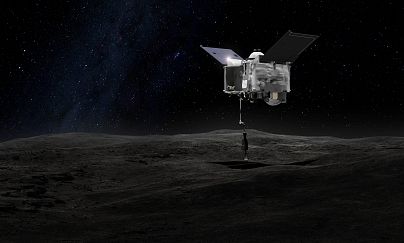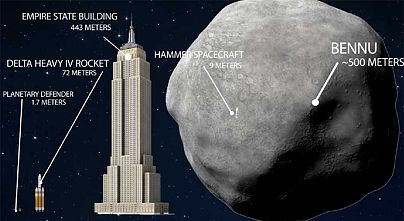It's the next step in the space agency's mission to bring a bit of an asteroid back to Earth.
Just days after its InSight lander touched down safely on Mars after a long, uncertain journey, NASA is getting set for another nail-biter: the arrival of the space agency's OSIRIS-REx spacecraft at its target, a skyscraper-size asteroid known as Bennu.
The long-anticipated rendezvous with the space rock will occur around noon EST on Dec. 3. NASA will live-stream coverage of the cosmic meet-up from 11:45 a.m. to 12:15 p.m. ET. A preview of the OSIRIS-REx mission will begin at 11:15 a.m. ET.
OSIRIS-REx — the name is an acronym for Origins, Spectral Interpretation, Resource Identification, Security-Regolith Explorer — launched into space in September 2016 and has been making its way toward Bennu since.
The looming arrival of the unmanned craft has energized members of the mission team.
"Like many team members, I have been working on this mission for many years," Sandy Freund, a mission manager at Lockheed Martin, the maker of the OSIRIS-REx spacecraft, told NBC News MACH in an email. "We have been waiting years to be at Bennu and are incredibly excited to see this asteroid up close."
As of Sunday afternoon, OSIRIS-REx was less than 20 miles from the asteroid, which itself is now about 76 million miles from Earth in its orbit around the sun. The craft will span the remaining distance to Bennu after another firing of its thrusters, which the team will monitor closely.
The spacecraft — a roughly cube-shape craft about eight feet on each side — will spend about a year surveying and mapping Bennu. If all goes well, the craft will lower its 11-foot robotic arm to the surface of the 1,600-foot-wide asteroid for a few seconds in 2020 to suck up a sample of regolith (the dust and pebbles believed to make up the asteroid).
The sample will return to Earth for study, scheduled to arrive in September 2023. It will be the biggest sample brought back from space since the Apollo era and the first sample of an asteroid ever returned to Earth by a U.S. space mission.
Japan's Hayabusa mission returned a small sample of an asteroid known as 25143 Itokawa in 2010; a successor craft, Hayabusa-2, arrived at an asteroid called Ryugu last year and is expected to return a sample in 2020.
"OSIRIS-REx and Hayabusa 2 are companion missions," Dante Lauretta, a planetary scientist at the University of Arizona and the principal investigator for the OSIRIS-REx mission, said in September. "We work together to understand the history of the solar system.
The OSIRIS-REx mission is designed to enhance our understanding of asteroids and the growth and evolution of our solar system as well as to yield insights into how life arose. The seven-year, $800-million mission is also intended to help assess the feasibility of asteroid mining and to help scientists find ways to keep large asteroids from colliding with Earth.
Bennu, which is one of 700,000 known asteroids in the solar system, is characterized as potentially hazardous because there's a chance it could collide with Earth in the late 22nd century.













